Wo wir kürzlich so in Retro-Stimmung waren, hier mehr vom etwas umgebauten Italeri-Klassiker (in 1:72) - die MiG-37Sh ‘бе́лая сова́’/ ‘Schnee-Eule’ (Ferret G).
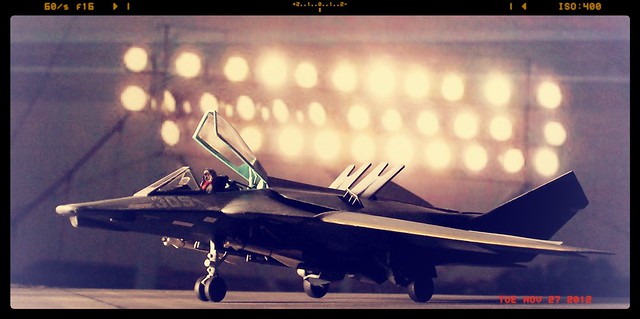
1:72 Italeri - MiG-37Sh ‘бе́лая сова́’/ ‘Snowy owl’ (Ferret G); Russian Air Force "305 Grey"; 970th IISAP, Lipetsk, 2001 (Whif/kit conversion) by
dizzyfugu, on Flickr
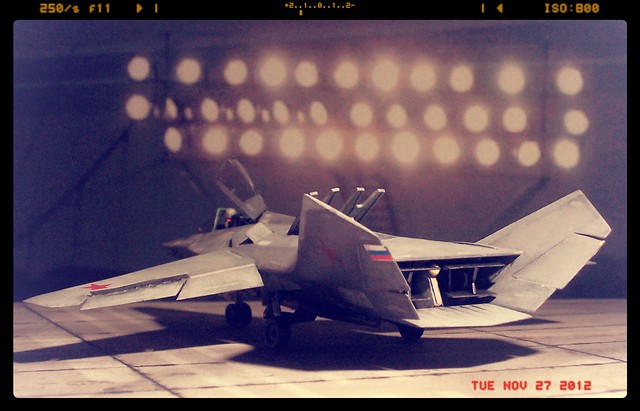
1:72 Italeri - MiG-37Sh ‘бе́лая сова́’/ ‘Snowy owl’ (Ferret G); Russian Air Force "305 Grey"; 970th IISAP, Lipetsk, 2001 (Whif/kit conversion) by
dizzyfugu, on Flickr
Some background:The MiG-37Sh (Sh = shturmovik) was a heavily modified version of the basic MiG-37 stealth attack and reconnaissance plane. Dissatisfaction with the basic MiG-37 sans suffixe in the air-to-ground role, esp. due to its limited internal weapon load and agility at low level of flight, and the need to replace the ageing Russian MiG-27 and early Su-25 fleet after the millennium led to a further and radical development of the basic airframe, while keeping the proven stealth features.
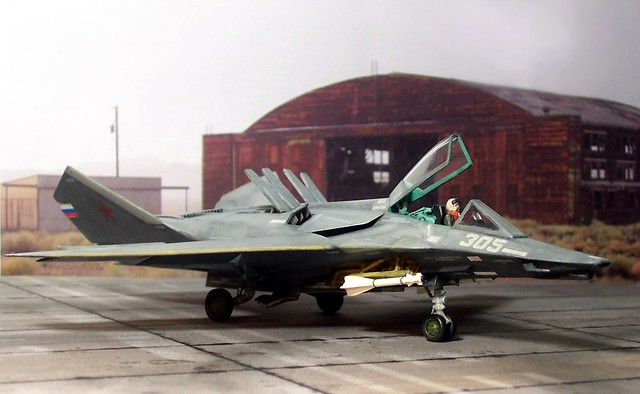
1:72 Italeri - MiG-37Sh ‘бе́лая сова́’/ ‘Snowy owl’ (Ferret G); Russian Air Force "305 Grey"; 970th IISAP, Lipetsk, 2001 (Whif/kit conversion) by dizzyfugu, on Flickr
The resulting 'Sh' variant was consequently optimized for all-weather ground attack, with a focus on a high chance of survival in front line service as well as an improved low-level handling and loiter time.
The 2nd generation 'Sh' prototype flew in summer 1999. A small number of MiG-37Sh has been built since, and in the long line of the MiG-37 development the aircraft received the NATO code ‘Ferret G’. Probably 20 of these machines serve alongside 1st generation versions of the MiG-37. Lack of funds seems to hamper large-scale production, even though the type already proved its effectiveness, e .g. in the Chechen conflict (see below).
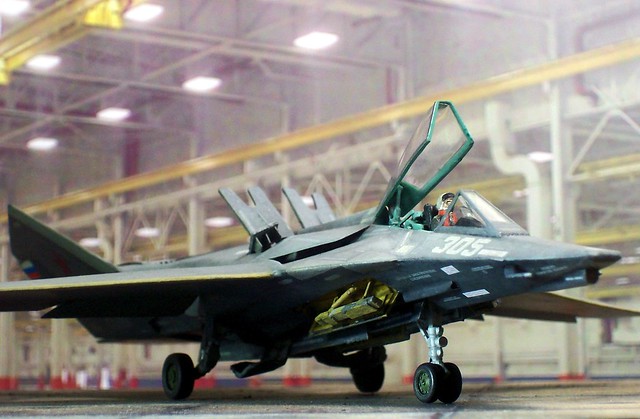
1:72 Italeri - MiG-37Sh ‘бе́лая сова́’/ ‘Snowy owl’ (Ferret G); Russian Air Force "305 Grey"; 970th IISAP, Lipetsk, 2001 (Whif/kit conversion) by dizzyfugu, on Flickr
Most visible difference of the new 'Sh' to its predecessors was a completely new wing. This new design featured a bigger wing span, lower sweep, a much higher aspect ration and also a much bigger profile. This new wings, together with the type's typical medium grey RAM surface coating, quickly earned it the nickname ‘бе́лая сова́ ‘ (‘Snowy owl’).
The new wings' anhedral had to be strongly reduced and the bigger internal wing space not only allowed additional fuel tanks to be integrated.

1:72 Italeri - MiG-37Sh ‘бе́лая сова́’/ ‘Snowy owl’ (Ferret G); Russian Air Force "305 Grey"; 970th IISAP, Lipetsk, 2001 (Whif/kit conversion) by dizzyfugu, on Flickr
The more rigid wing structure now also allowed the optional attachment of two hardpoint per wing for external ordnance loads, the inner ones being able to carry 1.000kg, the outer ones 500kg. The inner pair is ‘wet’ for PTB-800 drop tanks in ferry configuration, there seems to be no provision for an IFR probe installation. But compared to the 1st generation MiG-37 versions, this new feature considerable expands the offensive potential, esp. for long range deployment or when the plane is simply on a non-stealthy mission.

1:72 Italeri - MiG-37Sh ‘бе́лая сова́’/ ‘Snowy owl’ (Ferret G); Russian Air Force "305 Grey"; 970th IISAP, Lipetsk, 2001 (Whif/kit conversion) by dizzyfugu, on Flickr
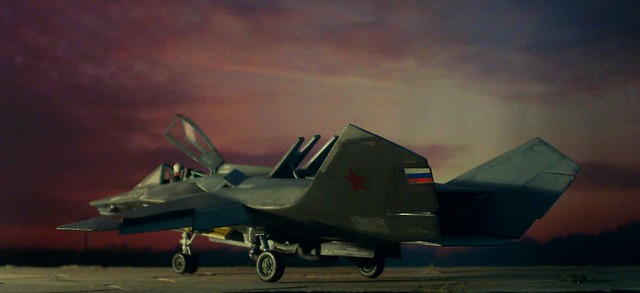
1:72 Italeri - MiG-37Sh ‘бе́лая сова́’/ ‘Snowy owl’ (Ferret G); Russian Air Force "305 Grey"; 970th IISAP, Lipetsk, 2001 (Whif/kit conversion) by dizzyfugu, on Flickr
Another new feature was a downward-sloping nose profile for improved pilot visibility. It also holds the highly effective Kyra-23 laser-television sighting system, which includes an A/W TV camera, a missile guidance antenna and integrates an S-31E2 KOLS, a combined laser rangefinder and IRST. This system more or less replaces an active, radar-based fire control system and is also installed on MiG-29 and Su27 interceptors. It provides exceptional gun-laying accuracy and is used for both air-to-ground guidance as well as to track and combat low-flying planes, helicopters and even cruise missiles.
The Mig-37Sh's PrNK-23K nav/attack system was borrowed from the sophisticated MiG-27K. It provides automatic flight control, gun firing, and weapons release. The capabilities of the aircraft in the ASM role are being enhanced by the incorporation of modern avionics systems consisting primarily of two Multi-Function Displays (MFDs) Mission and Display Processor (MDP), Sextant Ring Laser Gyros (RLG INSI), combined GPS/GLONASS navigation, HUD with UFCP, Digital Map Generator (DMG), jam-resistant Secured Communication, stand-by UHF communication, data link and a comprehensive Electronic Warfare (EW) Suite. A mission planning and retrieval facility, VTR and HUD Camera are also fitted.
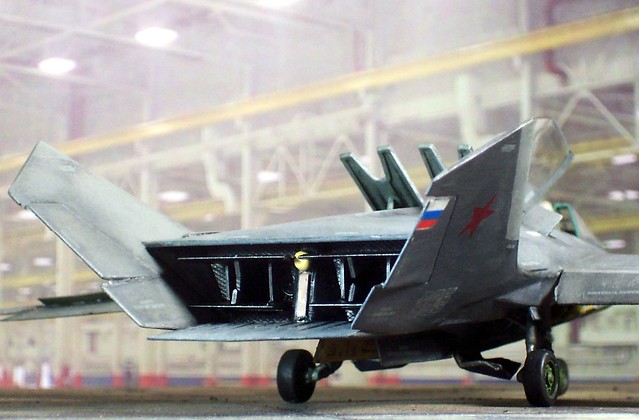
1:72 Italeri - MiG-37Sh ‘бе́лая сова́’/ ‘Snowy owl’ (Ferret G); Russian Air Force "305 Grey"; 970th IISAP, Lipetsk, 2001 (Whif/kit conversion) by dizzyfugu, on Flickr
The aircraft retains stand-by (conventional) instrumentation, including artificial horizon, altimeter and airspeed indicator, to cater for the failure of HUD and the MFDs. The modified plane also received much-improved electronic and Infra red countermeasure (ECM & IRCM) systems, including an SPO-15 radar homing & warning system (RHAWS) and an SO-69 identification-friend-or-foe (IFF) transponder.
Additional kevlar cockpit armour plates were installed. The undercarriage was revised to facilitate operation from poorer-quality airfields. It has a much simpler design and also allows more room under the plane for easier maintenance.
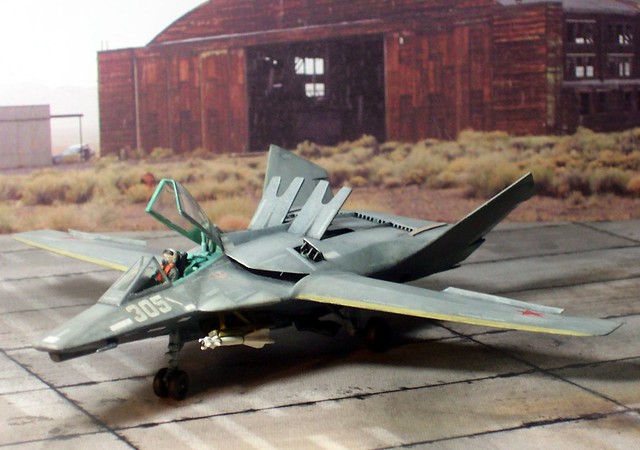
1:72 Italeri - MiG-37Sh ‘бе́лая сова́’/ ‘Snowy owl’ (Ferret G); Russian Air Force "305 Grey"; 970th IISAP, Lipetsk, 2001 (Whif/kit conversion) by dizzyfugu, on Flickr
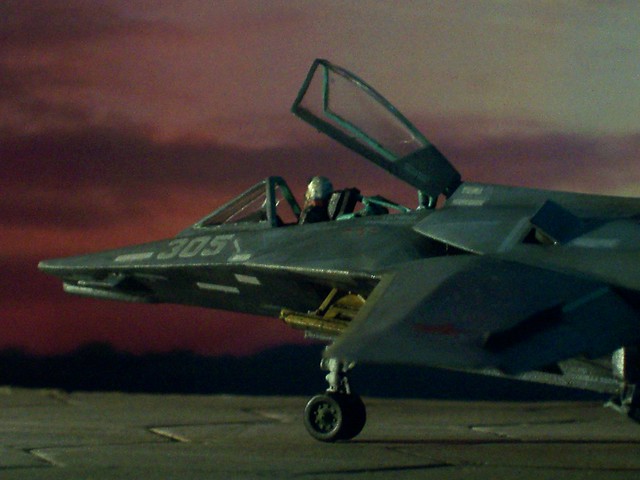
1:72 Italeri - MiG-37Sh ‘бе́лая сова́’/ ‘Snowy owl’ (Ferret G); Russian Air Force "305 Grey"; 970th IISAP, Lipetsk, 2001 (Whif/kit conversion) by dizzyfugu, on Flickr
In order to improve agility, the MiG-37Sh received two Klimov RD-33MK turbofans (the same as used in the MiG-29MK, without afterburner and a special nozzle arrangement which adds cold air for a reduced IR signature) and modified vectored trust nozzles. The latter are still 2D, as featured on the original MiG-37 design, but can now move independently so that roll and slow speed manoeuvrability are considerably enhanced – the MiG-37Sh is not solely a ground attack aircraft, it is also supposed to take on attack helicopters and even cruise missiles near ground level. Rumor has it that its agility is immense, largely limited by the g-forces the pilot can accept.
With the emphasis on strike and low-level attack requirements, a fixed single-barreled GSh-30-1 30mm cannon with 300 rounds was installed in a shallow fairing under the plane’s starboard belly. It features a closable nozzle, so that the radar and also IR signature of the weapon is minimized – it is only exposed when actually made ready to fire.

1:72 Italeri - MiG-37Sh ‘бе́лая сова́’/ ‘Snowy owl’ (Ferret G); Russian Air Force "305 Grey"; 970th IISAP, Lipetsk, 2001 (Whif/kit conversion) by dizzyfugu, on Flickr

1:72 Italeri - MiG-37Sh ‘бе́лая сова́’/ ‘Snowy owl’ (Ferret G); Russian Air Force "305 Grey"; 970th IISAP, Lipetsk, 2001 (Whif/kit conversion) by dizzyfugu, on Flickr
Compared to the MiG-37 sand suffix, provisions were made to mount more weapons, mainly missiles and precision-guided munitions against ground targets. Self defence and limited air-to-air capability was also on the designers’ agenda. Therefore, and thanks to the bigger fuel capacitiy in the bigger wing tanks, two additional internal weapon bays could be incorporated into the lower wing roots.
These are to store a single, compact R-60/AA-8 "Aphid" IR missile each, leaving the original weapon bays free for offensive armament like a single KAB-500 guided bomb in each of them.
Overall, the offensive potential of the ‘Sh’ variant increased tremendously compared to the 1st generation MiG-37 types: thanks to its uprated engines and the new wings with greater lift, the MiG-37Sh can carry up to 3 tons of weaponry, about 40% more than the original MiG-37 sans suffix. It is able to deliver strikes with much more accuracy, in all weather conditions and with a much higher chance of survivability in hostile environment.

1:72 Italeri - MiG-37Sh ‘бе́лая сова́’/ ‘Snowy owl’ (Ferret G); Russian Air Force "305 Grey"; 970th IISAP, Lipetsk, 2001 (Whif/kit conversion) by dizzyfugu, on Flickr
MiG-37 actively took part in the Russian Army's operations against rebels in the Chechen Republic. In December 2000, a pair of early production MiG-37Sh from Lipetsk-based 970 IISAP (Instructional & Test Composite Air Regiment) arrived to the area, accompanied by several Su-25, to provide reconnaissance and target designation in the conflict theatre.
The MiG-37Sh were quickly thrown into action: On 6 January 2001, the MiG-37Sh used live weapons against a real enemy for the first time. On 9 January, at the entry into a mountain gorge in the area of a settlement named Komsomolskoye, a single MiG-37Sh used Kh-29L missiles to destroy a warehouse full of ammunition belonging to Chechen insurgents.
On 6 February, in the forest-covered mountain area to the south of the village of Tsentoroj, the strike group composed of two MiG-37Sh and two Su-25 discovered and, from a range of 3 km, destroyed a fortified camp of insurgents using KAB-500L guided bombs.
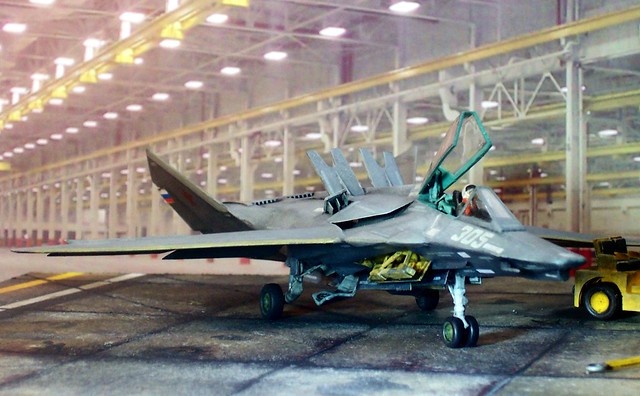
1:72 Italeri - MiG-37Sh ‘бе́лая сова́’/ ‘Snowy owl’ (Ferret G); Russian Air Force "305 Grey"; 970th IISAP, Lipetsk, 2001 (Whif/kit conversion) by dizzyfugu, on Flickr
14 February, saw a similar strike group carrying out a "hunting" mission in the area of Oak-Yurt and Hatun. In difficult conditions, pilots found and destroyed eight targets. These missions tested the type's airframe, as well as its on-board systems and armament. Its successful performance in difficult, mountainous terrain once again confirmed the usefulness of the many advanced features of the MiG-37Sh design, including its power and manoeuvrability.
It is unclear if the type has been used in combat since, e .g. in Afghanistan. It has participated in a number of exercises, though, including "Boundary 2004" which took place on the Edelweiss mountain range in Kyrgyzstan, in August 2004. Once again the "Ferret G" demonstrated its advantages by operating at a high altitude and an air temperature of more than 30 °C. Among other sorties, a single MiG-37Sh provided cover for the landing of troops, taking down two Ka-50 helicopters in mock air combat, and then successfully worked on ground targets using its precision weapons as well as unguided rockets.General characteristics:Crew: 1
Length: 53 ft 6 in (16.34 m)
Wingspan: 43 ft 1 1/2 in (13.18 m)
Height: 10 ft 9 in (3,24m)
Empty weight: 24.250 lbs (11.000 kg)
Loaded weight: 33.730 lbs (15.300 kg)
Max. takeoff weight: 39,690 lbs (18.000 kg)
Performance:Maximum speed: 610 mph (980 km/h)
Range: 1.030 miles (1.650 km)
Service ceiling: 39.400 ft (12.000 m)
Rate of climb: 12.960 ft/min (72 m/s)
Engine: 2 Klimov RD-33MK turbofans w/o afterburner rated at 53.0 kN (11,900 lbs.), fitted with 2D vectored thrust nozzles
Armament:1× GSh-30-1 30mm cannon with 300 rounds .
Four internal weapon bays (two bays for a single AA-8 "Aphid" or a twin ‘Igla’ light air-to-air missile starter; two bays in tandem fore and aft the main gear wells for various weapons incl. guided missiles and bombs).
Four external hard points (2 under each inner wing); total internal and external weapon ordnance 3.000kg.
Five UV-26 dispensers in the tail section (w. 120 chaff/flare cartridges in each pod)
Wer kennt (oder hat?) nicht die lustige MiG-37, den Russen-Faustkeil der 90er, der viele zu Varianten inspirierte. Dies ist meine vierte, und bei dieser wollte ich mehr aus dem Bausatz rausholen, einen gewissen Realismus einbauen. Insofern wurde einiges verändert: augenfällig die neuen Tragflächen, Implantate einer (fiesen) Revell F-117. Diese wurden gleich mit ausgefahrenen Landeklappen und Spoilern versehen.
Der ganze Heckbereich ist ebenfalls neu gemacht (separate 2D-Vektor-Steuerung), und der Bug wurde neu aufgebaut - oben flacher, unten ein eckiger Behälter. Auf dem Rumpf sind außerdem geöffnete Zusatz-Lufteinfläufe eingebaut, und untenrum gab es zwei zusätzliche Waffenschächte für R-60-Flugkörper, sowie eine verkleidete Kanone. Das Cockpit ist fast OOB, nur der Pilot kam hinzu und der Kasten hinterm Sitz.
Der Anstrich ist dagegen bewusst simpel ausgefallen: hellgrau von oben, dunkelgrau von unten (alles mit Emaille-Farben und Pinsel gemacht), und mit gedämpften Markierungen versehen. Zum Schluss gab's dann noch eine passende Hintergrund-Story.


1:72 Italeri - MiG-37Sh ‘бе́лая сова́’/ ‘Snowy owl’ (Ferret G); Russian Air Force "305 Grey"; 970th IISAP, Lipetsk, 2001 (Whif/kit conversion) by
dizzyfugu, on Flickr
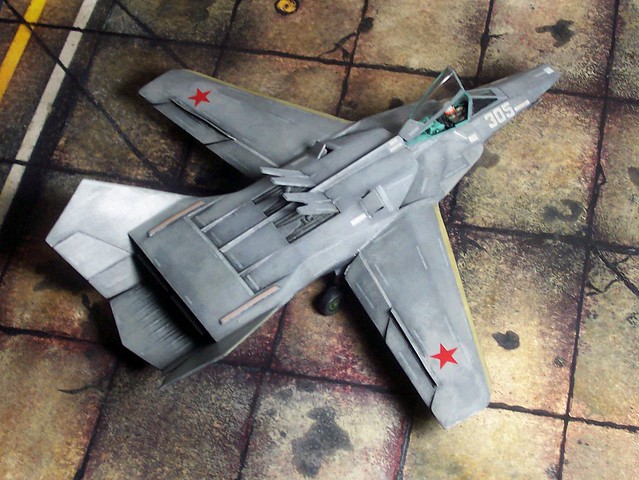
1:72 Italeri - MiG-37Sh ‘бе́лая сова́’/ ‘Snowy owl’ (Ferret G); Russian Air Force "305 Grey"; 970th IISAP, Lipetsk, 2001 (Whif/kit conversion) by
dizzyfugu, on Flickr
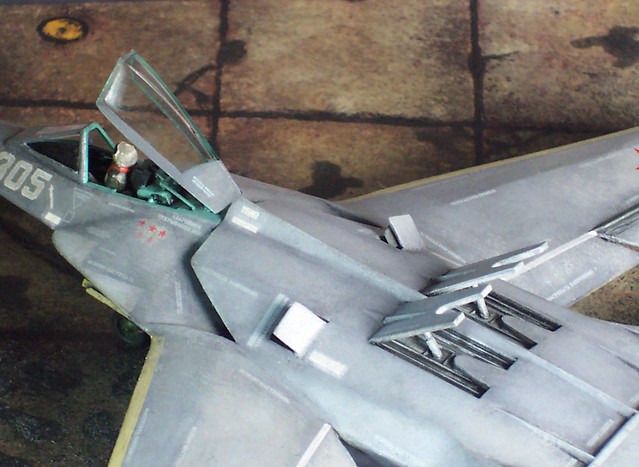
1:72 Italeri - MiG-37Sh ‘бе́лая сова́’/ ‘Snowy owl’ (Ferret G); Russian Air Force "305 Grey"; 970th IISAP, Lipetsk, 2001 (Whif/kit conversion) by
dizzyfugu, on Flickr
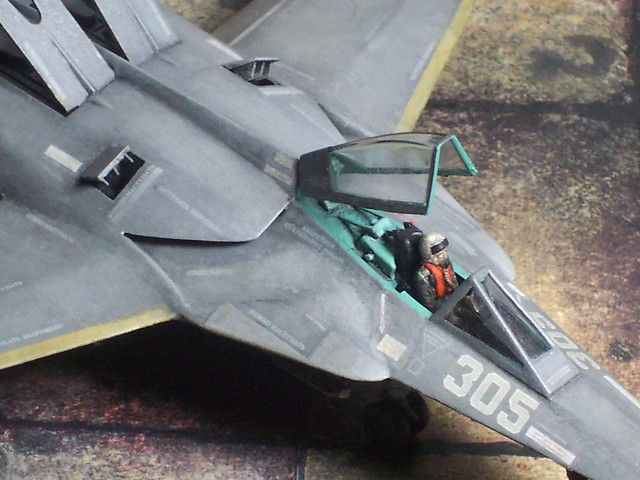
1:72 Italeri - MiG-37Sh ‘бе́лая сова́’/ ‘Snowy owl’ (Ferret G); Russian Air Force "305 Grey"; 970th IISAP, Lipetsk, 2001 (Whif/kit conversion) by
dizzyfugu, on Flickr